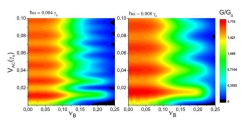Here we report theoretical transport calculations on carbon-based nanomaterials used as resonator cavities under the effects of a time-dependent field. A magnetic field is considered as an extra modulator tool, able to encode binary ON or OFF transmission states on the quantum systems. Regular either complex conductance Fabry-Perot patterns mapped onto gate vs.bias voltage diagrams can be revealed depending on the set of parameters used on the simulations (amplitude and frequency of the ac field and magnetic-field intensity). We discuss the interplay between the effects on the resonant cavity conductance, caused by the presence of an ac gate plate, which tends to delocalize the electronic wave functions, and an external magnetic field that oppositely localizes the electrons.

Here we report theoretical transport calculations on carbon-based nanomaterials used as resonator cavities under the effects of a time-dependent field. A magnetic field is considered as an extra modulator tool, able to encode binary ON or OFF transmission states on the quantum systems. Regular either complex conductance Fabry-Perot patterns mapped onto gate vs.bias voltage diagrams can be revealed depending on the set of parameters used on the simulations (amplitude and frequency of the ac field and magnetic-field intensity). We discuss the interplay between the effects on the resonant cavity conductance, caused by the presence of an ac gate plate, which tends to delocalize the electronic wave functions, and an external magnetic field that oppositely localizes the electrons.
